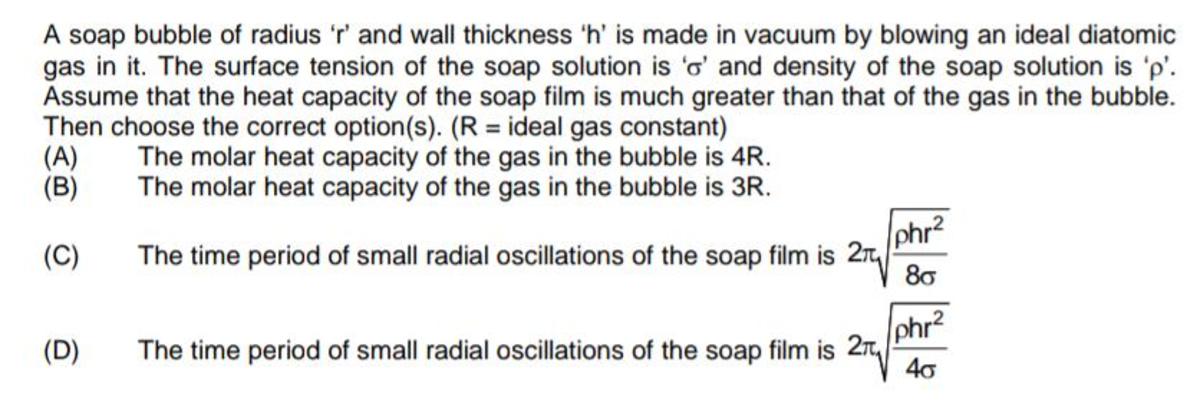Cardinality Of Inequations!
Let A = { x : x ∈ R , x 2 − 4 ≥ 0 } and B = { y : y ∈ R − { 0 } , 4 y 2 − 1 ≤ 0 } .
Also, denote ∣ X ∣ as the cardinality of the set X , then which of the statements is true?
All of my problems are original .
This section requires Javascript.
You are seeing this because something didn't load right. We suggest you, (a) try
refreshing the page, (b) enabling javascript if it is disabled on your browser and,
finally, (c)
loading the
non-javascript version of this page
. We're sorry about the hassle.
1 solution
@Aryan Sanghi Again a fun one. Thanks
Log in to reply
Thanku for appreciation. :)
Log in to reply
@Aryan Sanghi Van you help me
Log in to reply
@Talulah Riley – Yes, any doubt?
Log in to reply
@Aryan Sanghi – @Aryan Sanghi Ask your brother that, which book he reffered for practice of maths question for jee advance.
Log in to reply
@Talulah Riley – Cengage. He referred it for Physics, Maths, Organic and Physical Chemistry.
@Aryan Sanghi – @Aryan Sanghi Give a congrats from my side for 1 8 8 .
Log in to reply
@Talulah Riley – Thanks - from my brother.
Log in to reply
@Aryan Sanghi
–
@Aryan Sanghi i think you are just saying that from your side.
I am targeting below 1k.
Log in to reply
@Talulah Riley – Actually it was really from his side, he is sitting beside me. :)
Log in to reply
@Aryan Sanghi – @Aryan Sanghi You are so much LUCKY. A Einstein is sitting in front of you.
@Aryan Sanghi And what for inorganic??
Log in to reply
NCERT and VK Jaiswal for questions.
Log in to reply
@Aryan Sanghi If I will read ncert line to line for inorganic, will I be able to solve inorganic 90% questions.
Log in to reply
@Talulah Riley – He is saying if you'll mug up NCERT fully, you'll be able to solve 100% of the questions.
Log in to reply
@Aryan Sanghi – @Aryan Sanghi Inorganic ke liye hai na 100% bro?
Log in to reply
@Talulah Riley – Yes, for Inorganic.
Log in to reply
@Aryan Sanghi – @Aryan Sanghi And one thing more, Binomial , permutation and combination, complex, Solution of triangke iske liye aapke bhaiya ne puri cengage solve kari thi kya? Aur fiitjee ka package bhi kya?
Log in to reply
@Talulah Riley – Yes, he did solve it.
Log in to reply
@Aryan Sanghi – @Aryan Sanghi Did he solved all review package?
Log in to reply
@Talulah Riley – He didn't solve completely, but solved them to large extent.
Log in to reply
@Aryan Sanghi
–
@Aryan Sanghi
Thanks for giving such a precious information.
How much you are expecting your rank?
You will probably come under 10.
Log in to reply
@Talulah Riley – Thanku for your belief in me for my rank. I want to be under 1 0 0 , and I am putting my efforts, hope I'll achieve it. :)
Log in to reply
@Aryan Sanghi
–
@Aryan Sanghi
Welcome.
By the way did your brother solved whole irodov book?
If no then how much.
Btw I have solved 60% irodov in lockdown period and didn't studied chemistry, and now I am regreting it.
But now I am studying chemistry whole day.
Log in to reply
@Talulah Riley – He didn't solve it Fully, he doesn't remember how much he solved(obvious as it is 5 year old for him). But, he does suggest me to solve irodov, and says it's very good.
Log in to reply
@Aryan Sanghi – @Aryan Sanghi Thanks for the information. Let's meet at IIT M. Bye
@Aryan Sanghi ,I just clicked equal by thinking that they both are infinite .. Lol....But,from your solution,I have understood it. Nice solution.
One more thing,If we are not able to map a function.Then,they won't be equal. right ? And we can't say which is bigger.
Log in to reply
Actually, there are terms to define which is bigger too, you could check out the wiki I provided in question. :)
Log in to reply
@Aryan Sanghi
Bro can you solve this

Or can you provide me the solution from somewhere else, whenever you will be free. I will be very grateful.
Thanks in advance.
Log in to reply
Hi. Sorry, I haven't studied thermodynamics yet. So, I won't be able to help. :(
Set A
Let's find Solution set of x 2 − 4 ≥ 0
x 2 − 4 ≥ 0 ( x + 2 ) ( x − 2 ) ≥ 0 x ∈ ( − ∞ , − 2 ] ∪ [ 2 , ∞ )
Therefore, set A is A = ( − ∞ , − 2 ] ∪ [ 2 , ∞ )
Set B
Let's find Solution set of 4 y 2 − 1 ≥ 0
4 y 2 − 1 ≤ 0 ( 2 y + 1 ) ( 2 y − 1 ) ≤ 0 y ∈ [ − 2 1 , 2 1 ]
Therefore, set B is B = [ − 2 1 , 2 1 ] − { 0 }
Proving ∣ A ∣ = ∣ B ∣
Two sets are said to be equivalent if there exists a bijection f : A → B .
Now, for all x in A there exists y in B such that y = x 1
Also, for all y in B there exists x in A such that x = y 1
Therefore there exists a bijection f : A → B which is f ( x ) = x 1
Therefore ∣ A ∣ = ∣ B ∣